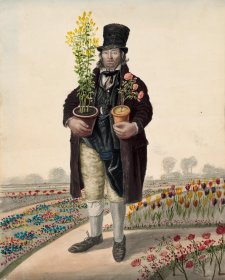Today the beadle is chiefly remembered through the person of Charles Dickens’ Mr Bumble, the portly, blustering bully who cried ‘Whaat!?’ when Oliver Twist asked for more gruel.
A servant of the parish vestry or town corporation, the beadle’s original and principal business was ‘to prevent any riotous behaviour taking place by idle and dissolute people, during the performance of divine service’. In Shakespeare’s Henry VI, Part II (Act II Scene 1) he is a more general policeman: ‘Mayor of St Alban’s: Sirrah go fetch the Beadle hither straight … (Enter a Beadle with whips)’. This constabulary function continued: the Winchester beadle’s salary bill for 1784 included a two-shilling allowance for ‘straw for dungeon’.
The beadle’s job description was also variously extended in different parishes and towns; in the 18th century we find beadles acting as vestry messengers, record-keepers and criers, as keepers of militia lists and as collectors of Poor Rates. A critical and almost universal duty was to ensure that vagrants and beggars from outside the parish were sent on their way and, in the early 19th century, this function consolidated in Mr Bumble’s position as a kind of general monitor of the poor.
Beadles also had a ceremonial function. William Pyne in his Costume of Great Britain of 1808 depicts three beadles leading the triennial procession of charity children ‘to trace and preserve the (parish) boundaries’.
Dempsey’s beadle appears altogether more practical. He has no lace, brass buckles or gilded staff but is dressed in a workaday suit of brown corduroy breeches and waistcoat, and carries a sturdy, knobbed stick. He does, however, wear the beadle’s standard uniform of blue coat with scarlet collar and cuffs. The gold-trimmed top hat is a Regency update of the more traditional tricorn seen in Pyne’s illustration. The Winchester mayoral accounts for 1808–09 record payment of 16 shillings to a Mr Sanger for supplying such coats to both beadle and bellman. These same accounts also contain reference to the beadle’s somewhat meagre wages: eight shillings per week, an annual income of £20.16.0, which was rather less than that of an agricultural labourer. At Mitcham, Surrey in 1801 the salary was 50 guineas a year, with hat and coat supplied.
The name of Dempsey’s Winchester beadle is not known. However, corporation records for 1788–89 identify the beadle of that year as George Norkett, and it is just conceivable that the grizzled veteran of this 1823 watercolour is the same man 35 years on.
Collection: Tasmanian Museum and Art Gallery, presented by C. Docker, 1956



Dempsey’s people: a folio of British street portraits 1824–1844 is the first exhibition to showcase the compelling watercolour images of English street people made by the itinerant English painter John Dempsey throughout the first half of the nineteenth century.



Visit us, learn with us, support us or work with us! Here’s a range of information about planning your visit, our history and more!



We depend on your support to keep creating our programs, exhibitions, publications and building the amazing portrait collection!